In 2015, smelly mats of a brown macroalgae called sargassum piled as high as 4 feet on the beaches of Barbados, recalls Joshua Forte. It was the fourth year in what has become an annual nightmare, with an estimated 20 tons of seaweed inundating Caribbean shorelines each year and wrecking the region’s tourism-centered economies.
The onslaught of seaweed reeked of rotten eggs, but Forte smelled something else: opportunity.
A year earlier, Forte founded an organic fertilizer company called Red Diamond Compost. He was already selling a soil additive from sunflower seeds called Liquid Sunshine. But the sargassum seemed too big to ignore.
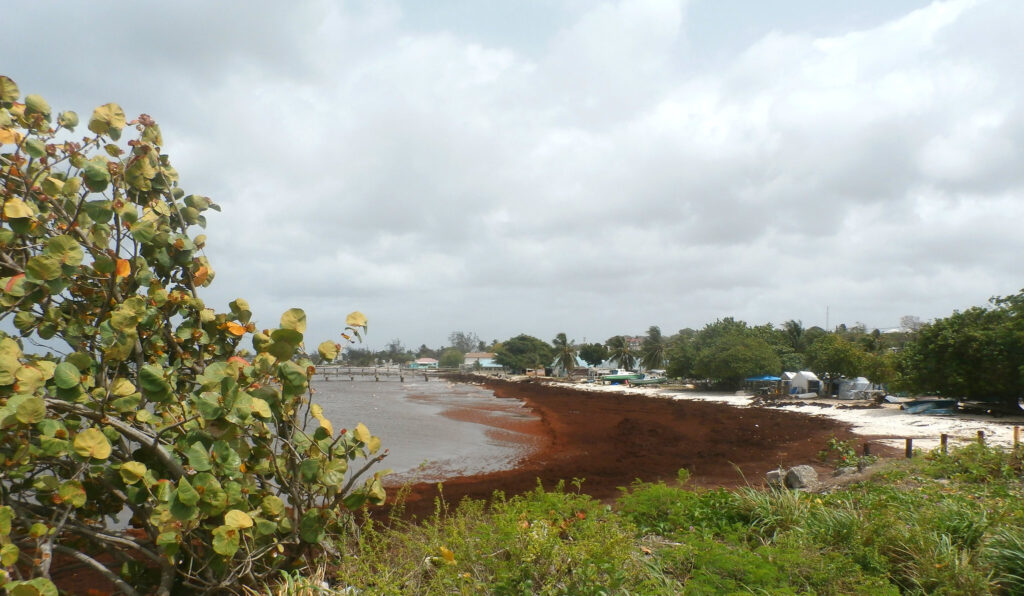
So, Forte started to collect the seaweed by hand, hauling 60-pound bags of it into the back of a pickup truck. It became the raw material for a new product called Supreme Sea, a soil additive that includes growth-stimulating plant hormones and microorganisms extracted from the sargassum. After extraction, Forte composts what’s left over into a humus-rich product that’s safe for crops. The idea was to “have as big of an impact as possible on the influx of sargassum while contributing in a positive way to agriculture,” Forte told Mongabay.
Sargassum contains a slew of nutrients, minerals and microorganisms that can foster and even accelerate plant growth, such as iron, magnesium, potassium, calcium and more. But rather than add nutrients such as nitrogen and phosphorus into the soil, it does something savvy: Its properties help plants be more efficient at taking up those nutrients, incentivizing less synthetic fertilizer application in exchange for higher yields and healthier plants and crops. It’s a trending solution that could double as both a regional economic opportunity and a new tool for agroecology, a sustainable farming approach that targets food security in tandem with environmental health. Now, a few other entrepreneurs across the Caribbean are developing an industry for sargassum-based agricultural products — and interest is growing, Forte said.
“It could be really huge for the Caribbean economy,” said Allen McGonagill, the chief sustainability officer for Carbonwave, a company collecting sargassum in Mexico and Puerto Rico. He said sargassum can be used to make a slew of products, from plastic- and leather-like materials to biofuels and cosmetics. If these industries become large enough, they could collectively keep sargassum off the beaches, which would be a boon for the tourism sector.
Scientists think nitrogen pollution from agricultural runoff in the Amazon River Basin is one of the main reasons why the sargassum blooms have grown so out of control over the past decade or so, in addition to warmer ocean temperatures from climate change and increased volumes of Saharan dust, which carries added nutrients as it wafts over the Atlantic Ocean.
“Taking what nature is producing in overabundance and finding good uses for that is just such a better way of thinking about how we produce materials than the synthetics mindset” of prioritizing cookie-cutter production, McGonagill told Mongabay. A branch of Carbonwave, called Sarga Agriscience, is specifically focused on creating a plant-growth extract called SargaExtra.
“Sargassum lends itself to the agriculture side, primarily because of the volume,” said Jonas Kunz, Carbonwave’s agriculture director. Plus, he added, sargassum “has this kind of natural cocktail of good ingredients.”
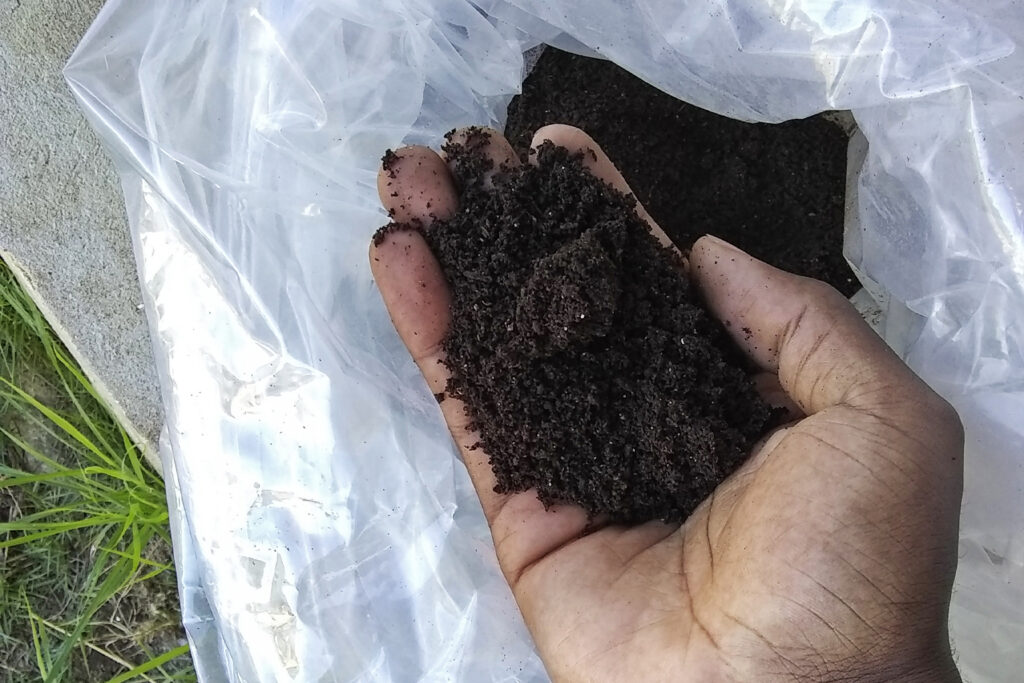
Sargassum acts like a sponge in the ocean, absorbing nutrients and minerals as it floats around the Atlantic. But that comes with one particularly dangerous drawback: Much of the seaweed contains high levels of arsenic, making it extremely dangerous to apply on soil without treating it first. Some farmers in Vieques, Puerto Rico, did just that, prompting an island-wide law prohibiting the use of sargassum for fertilizers and composts.
To avoid this health hazard, fertilizer companies, as well as folks creating at-home versions of composts from sargassum, need to properly rinse and process the seaweed. At Sarga Agriscience, this was a crucial step in the company’s development.
“We had to really look at the extraction method, and we found ways in which we can essentially extract all the good stuff and concentrate that,” Kunz said. Carbonwave uses a cold-pressing process, squeezing out the nutrients without destroying any of the beneficial proteins with heat or acids. They also don’t use heavy chemicals to filter out the unwanted ingredients, such as heavy metals. Other ways of turning sargassum into organic agricultural products are by fermentation, where microbes break down sugars and other components, or by drying the seaweed and then grinding it up. The latter doesn’t make the valuable components accessible to plants because they’re still trapped inside the cells, McGonagill explained.
Sargassum’s ability to absorb nutrients also makes it a helpful aid to terrestrial plants. “We’re helping the [crop] plant be more efficient at taking those nutrients out of the soil,” McGonagill added.
It’s a tool that can help boost yields as much as 10%, Kunz said — a significant increase. So far, their team has seen the best results in barley, corn and soy. And while organic additives such as SargaExtra and other biostimulants aren’t total replacements for fertilizer, they can reduce the amount needed.
A nutrient-pollution solution
Sargassum-based plant growth products, such as SargaExtra and Red Diamond’s Supreme Sea, may be efficient means of not only reducing sargassum on coastlines, but also of reducing nitrogen inputs in soil.
Nitrogen loads from synthetic fertilizers pose a global problem: When excess fertilizer runs off into rivers, lakes and oceans, or when it trickles down into groundwater, it creates a nitrogen surplus, which can cause harmful algal blooms and threaten human health.
As a case in point, Red Diamond conducted trials of its Supreme Sea biostimulant on sports turfs in the United Kingdom with synthetic fertilizers to test which combination resulted in the most optimal turf color. They found that halving the quantity of synthetic fertilizers while using Supreme Sea produced better color than synthetic fertilizers alone.
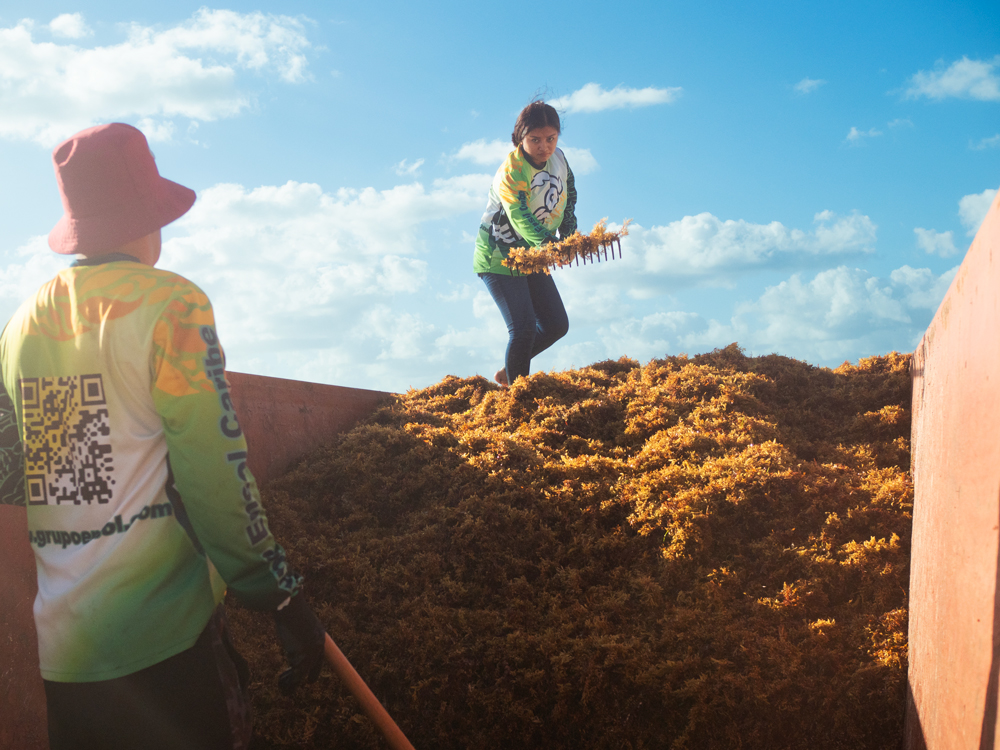
“We were trying to understand … how the product affects the efficiency of the nutrient uptake by the plants,” Forte said. “[The result] kind of indicates that a lot of nitrogen is still being put into the environment that’s not necessary.”
Red Diamond has tested its biostimulant in other locations too. Field trials in Spain showed yield increases in tomatoes and cucumbers, and they’re beginning to test products in Cameroon and other African countries. Forte said they aim to improve food security and soil health around the world.
There’s a huge need for that type of improvement in the Caribbean alone.
“I don’t think we have paid as much attention to producing good food the way we used to produce good food,” said Marcia Brandon, managing director for the Caribbean Centre of Excellence for Sustainable Livelihoods, a Barbados-based NGO dedicated to helping entrepreneurs kickstart their ideas. “We are known in this region for producing agriculture … but somehow, we let it slip away with the introduction of fertilizers and different chemicals. We have not stood guard over our own food supply.”
Brandon considers Red Diamond part of the solution to food security and sovereignty in the Caribbean. If Barbados can reinvigorate its soil and use more sustainable products like Forte’s, she said, then the island could undo its dependence on chemicals within the next decade.
Farmers are generally opposed to reducing their fertilizer inputs, McGonagill said, so he hopes products like SargaExtra can incentivize cutting back on fertilizer use by a small percentage.
“We do see part of our role as harnessing those nutrients and then putting (them) back into agriculture,” he said.
A challenging waste source
While these products are intended to boost agricultural yields and residential gardens, the other major function is, of course, to help reduce the massive amounts of sargassum hitting shorelines.
“It is a waste source,” McGonagill said, noting that prior to the inaugural onslaught in 2011, sargassum was scarce on Caribbean beaches. He added that it’s helpful to think of sargassum more as an invasive species — a foreign, nuisance organism that needs to be removed.
“While I think we are one of the largest companies that are collecting sargassum and trying to put it to use, we are still only scratching the surface,” McGonagill said.
Indeed, of the 20 million estimated tons of sargassum that makes its way across the Caribbean each year, Carbonwave collected just 25,000 tons last year.
“If the agricultural industry adopted sargassum-based extracts, it could entirely solve the problem of sargassum on the beaches,” McGonagill added. “But, obviously, that’s a big transition for the industry.”
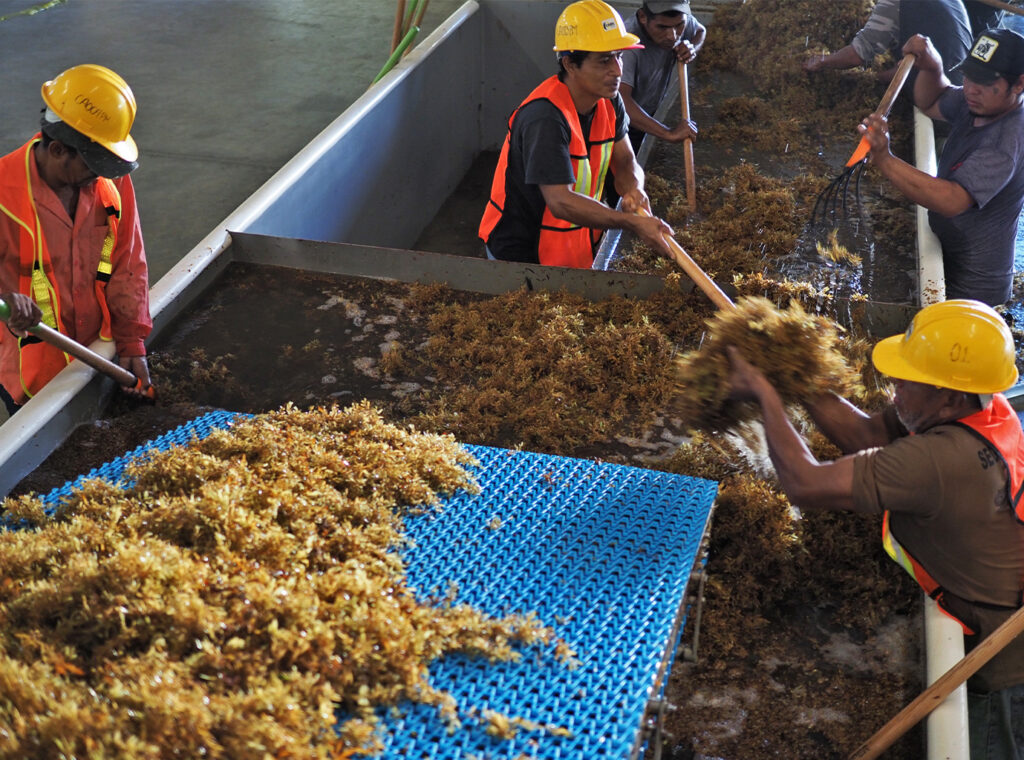
Seasonality remains one of the biggest challenges to scaling up production. Although huge amounts of sargassum hit the beaches annually from March to October, it isn’t available year-round. Plus, the exact amount varies from year to year. Estimates currently rely on a combination of satellite data and manual measurements on beaches. As of yet, accurate estimates are difficult to pin down.
For that reason, Sarga Ag produces extra product during sargassum season and plans for the remaining inventory. Their liquid product can stay stored on shelves, but for smaller companies, this seasonality is a barrier to establishing a reliable sargassum-based business.
“There is a problem: It is not predictable,” said Daveian Morrison, the founder of a Jamaican company called Awganic Inputs that was using sargassum for goat feed. But when Morrison saw research citing concerns about arsenic levels, he abandoned goat-feed production. He said he’d like to see more research on arsenic levels across the Caribbean to gain a better understanding of how it’s distributed throughout the environment — and he would eagerly jump back into the goat feed sector once the science is clearer.
Many studies have quantified arsenic concentrations in sargassum across the Caribbean in an attempt to assess its scope. But concentrations vary from location to location, making localized testing necessary.
Collecting large volumes of seaweed is, no pun intended, another major barrier. Not only is timing essential, but using boats and equipment is a considerable cost compared with the time-intensive manual labor of collecting sargassum by hand.
That’s why Forte’s next big investment at Red Diamond is a floating barrier with netting that extends 3 feet deep to capture sargassum before it hits the shore. This could also help trap the seaweed for weeks as a way to extend the time it’s available for harvest.
As soon as sargassum hits the shore, it starts to decompose. This releases smelly hydrogen sulfide and ammonia into the air, powerful toxins that can cause respiratory issues. And while it can be collected from beaches, it needs to be fresh enough to use for biofertilizers.
Carbonwave mostly collects seaweed onshore and in the shallows; collecting it too far offshore, McGonagill pointed out, can disrupt the seaweed’s function as a nursery for small fish and other critters in the open ocean. But beached sargassum can entangle wildlife, including preventing sea turtle hatchlings from reaching the water.
Small-scale industry or regional boon?
While the industry remains a small club, the issue isn’t going away. Mexico uses sargassum for a long list of products, such as eco-concrete and biogas. And in Miami, a recent initiative offered cash prizes for innovative uses of sargassum as a mitigation measure, including Carbonwave and a St. Lucian biofertilizer company called Algas Organics. As the industry grows, Morrison anticipated that “ownership” over sargassum, depending on its location in the water, could become a point of contention.
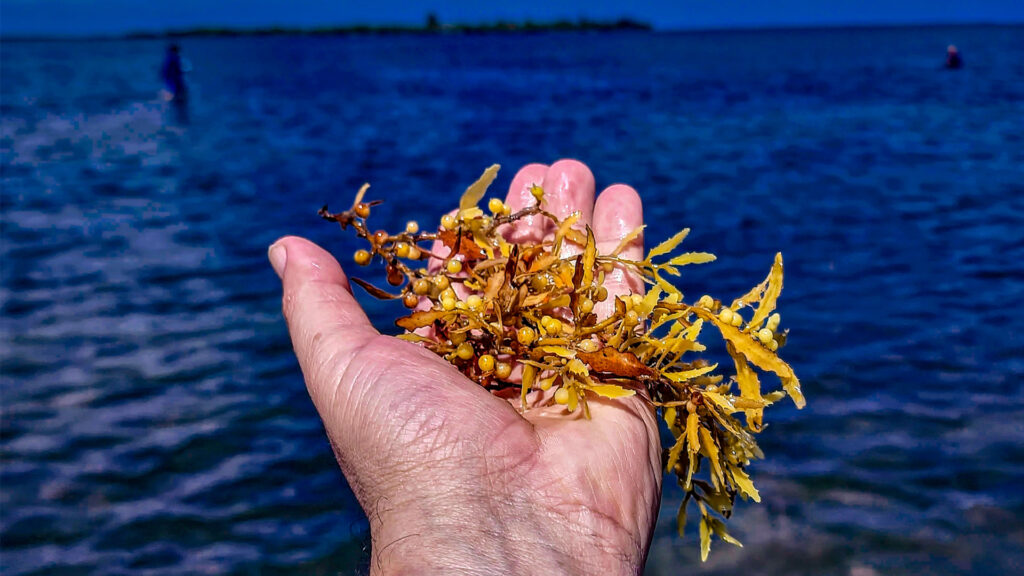
For now, the agroecological benefits of using sargassum to help produce more nutritious food are what keep Forte motivated at Red Diamond.
As a child, his grandmother’s garden was paradise. He climbed mango trees, plucked ripe bananas off the stems and stole the occasional “finger fruit,” a local term for carambola (star fruit, Averrhoa carambola), as an afternoon snack. Forte watched as she recycled plant matter back into the soil, allowing the crops to proliferate year-round.
Looking back, Forte realized his grandmother was practicing what is now called permaculture, a style of agroecology that prioritizes recycling nutrients in a zero-waste manner.
“Nature is something that is ever-changing,” Forte said. “We have to be as flexible and as adaptable as nature to be able to work with it effectively.”
Mongabay is a U.S.-based nonprofit conservation and environmental science news platform. This piece was originally published at https://news.mongabay.com/2024/04/caribbean-startups-are-turning-excess-seaweed-into-an-agroecology-solution/.
Sign up for The Invading Sea newsletter by visiting here. If you are interested in submitting an opinion piece to The Invading Sea, email Editor Nathan Crabbe at ncrabbe@fau.edu.



